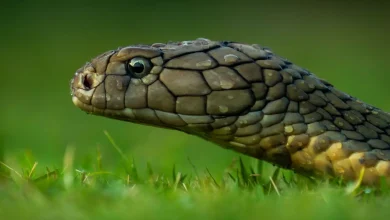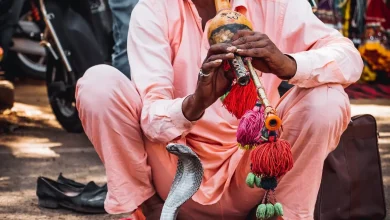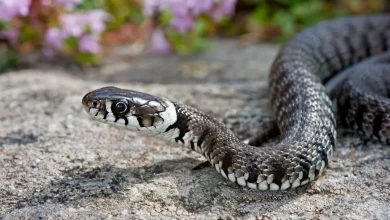13 Common Snake Myths (all false)
One of the main things that scare people about snakes, and make them fearful is things they don’t know or understand. Things that are uncertain can scare us. Snake facts are not widely known, and many myths have spread because well, let’s be honest, it’s more advantageous to kill a snake in your yard or house than it is to let it live and possibly return later.
Most people lack the training to know all 230+ snakes in Thailand and their usual first action is to try to kill the snake – not knowing if it’s venomous or not, and definitely not wanting it to return again later.
In this post, I want to look at some of the common snake, myths and debunk them, or tell you the truth about them so that you don’t fear snakes more than you need to.
Common Snake Myths
- Snakes are Slimy. This is a widely held belief, but unless you just pulled the snake from a slimy lake, stream, or puddle, it isn’t going to be slimy at all. Snakes on land are dry and their scales and interstitial skin (skin between scales) don’t retain water. They are smooth and dry. Their scales aid in movement and serve as protection.
- All Snakes are Venomous. Many people believe that all snakes are venomous and pose a danger to humans. In truth, the majority of snake species across the globe are non-venomous, and only a small percentage are venomous. Here in Thailand, we have around 230 known snake species in the ocean and on land. Of those, about 75 are venomous, and many of those are in the ocean. On land, we have about 40 venomous snakes that can cause medically significant bites.
- All Venomous Snakes are Deadly. While some venomous snakes can be dangerous, not all are lethal to humans. In fact, with a quick hospital visit, you should be fine. Children are at greater risk for severe complications and getting to the closest public hospital is very important when they are bitten. The severity of a snakebite largely depends on factors like the species (venom type and ability to inject), the amount of venom injected, and the location of the bite on the body. Fun Fact – 30-70% of bites by all venomous snakes in Thailand are “Dry Bites.” This means that very little or no venom is injected during the bite, and there will be very few (if any) symptoms.
- Snakes are Aggressive. This is almost 100% false. There are, very rarely, attacks on humans by pythons that intend to make you a meal. This happens a couple of times each year on average along the Burmese/Thai border and it usually happens when someone is sleeping on the ground. Every other snake species seems to be afraid of humans and doesn’t want ANY interaction at all. Snakes are good at defense against humans, but they are not on the offense to attack or track us down.
- Snakes Chase People. Snakes do not chase humans or intentionally pursue them. If a snake is moving in your direction, it is likely trying to escape and find cover, not attack. Remember, snakes have poor eyesight and can only see clearly when things are moving. If you’re standing still, you may blend in with the scenery and they don’t even notice you.
- Eye Shape Correlates with Venomous Snakes. No. There are many different eye shapes and in Thailand, the king cobra has an obvious round eye and pupil shape, while the pit vipers (all?) have slit-shaped pupils. Non-venomous cat snakes also have slit-shaped pupils. It’s all a mixed bag and you can’t tell anything about the dangerousness of a snake by the eye or pupil shape.
- You Should Cut an X Over a Snakebite to Suck Out the Venom. This is a dangerous and ineffective myth. Cutting or sucking on a snakebite can lead to infection and worsen the situation. The appropriate action is to seek immediate medical attention at a public hospital that hopefully has antivenin. In Thailand, large public hospitals are required to carry antivenin for venomous snakes in their area.
- Baby Snakes are More Dangerous than Adults. Juvenile snakes may have venom that is a bit more concentrated, but they also have much less venom than adult snakes. The amount of danger a snake is capable of has more to do with its actions and strike speed, distance, and temperament.
- Snakes Can Hypnotize You. Obviously, snakes don’t possess any sort of supernatural power over humans and they cannot hypnotize any humans or prey before striking. Snakes use stealth and quick movements to capture their prey.
- Snakes will Get Revenge. Snakes do not have the cognitive capacity for emotions like vengeance or grudges. They act solely on instinct and survival. The ‘mate’ of a female king cobra you killed yesterday is not going to return to take your life because of any revenge.
- You Have 10 Minutes to Live if Bitten by a Cobra (Krait, Pit Viper, Coral Snake, Blind Snake). It’s important to get to a public hospital as soon as possible once bitten by a snake. The most dangerous snake to be bitten by in terms of the ability to cause death quickly is the King Cobra. There have been a number of deaths that have occurred in less than 10 minutes from this snake. This is the only snake with venom known to act that fast. Of course, with children, even a monocled cobra, krait, or coral snake could probably cause death quite quickly. So don’t delay, go to the hospital immediately if bitten by a snake you are not 100% sure is non-venomous.
- The Blind Snakes are Deadly. These little snakes are completely harmless and open their mouths just enough to give you a little nip. They have no venom that is harmful to humans or pets. This is a pervasive myth all over the world because these snakes can be found just about everywhere. The photo at the top of the page is a blind snake. They are usually 3-6 inches long, shiny, and come up through plumbing (drain pipes) most often and into your shower or drains.
- Snakes are Poisonous. This is largely a myth. As far as we know here in Thailand, there is only one snake that is poisonous and venomous – Rhabdophis siamensis, the Red-necked Keelback). Poisonous means if you eat it, you will have a medical issue. This snake excretes poison on the neck from its nuchal glands when threatened. If a snake is venomous, it means that venom is injected with fangs or repeated biting with teeth (Red-necked Keelback).
If you hear of any more snake myths, I’d love to add them to the list. Add in the comments please!
More Thailand Snake Notes >




